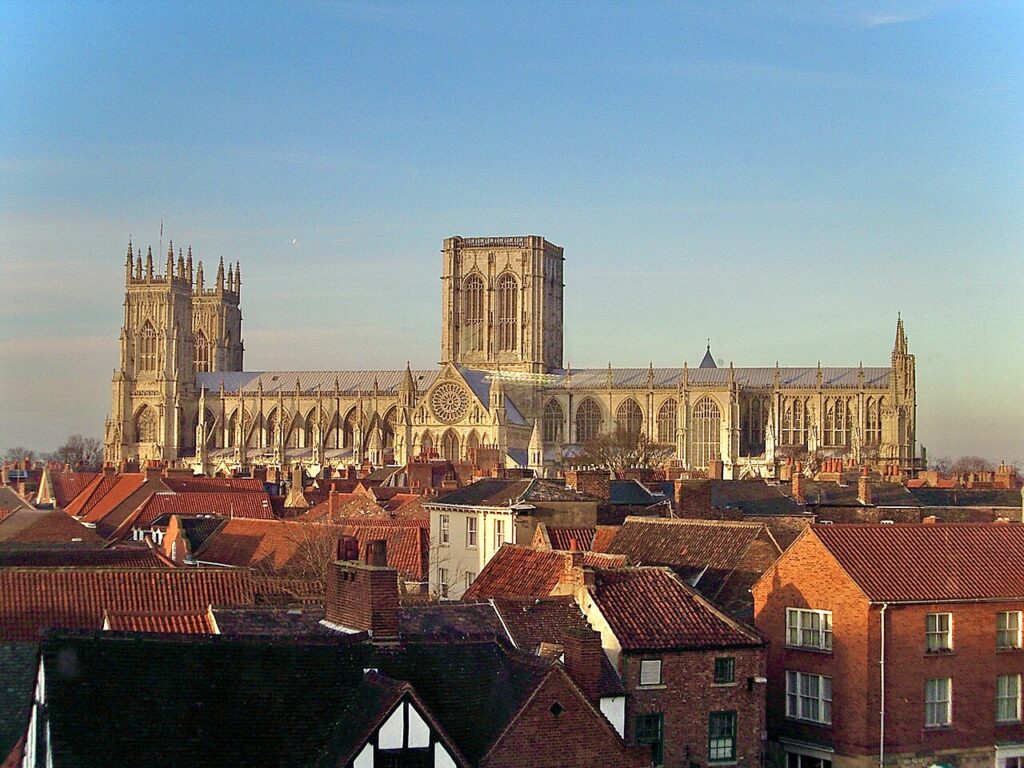York Minster

York Minster: A Historical Overview with Emphasis on the Anglo-Saxon Period
York Minster, one of the largest and most important Gothic cathedrals in Northern Europe, is a testament to the enduring significance of York as a religious and political center. While the present structure largely dates from the 13th to the 15th centuries, its history is deeply rooted in the Anglo-Saxon period, a time when York played a crucial role in the early Christianization of England and the formation of its religious institutions.
Early Beginnings: The Roman and Anglo-Saxon Foundations
York, known as Eboracum during the Roman period, was already a prominent city by the time of the Anglo-Saxon arrival. The Roman military fortress laid the groundwork for the city’s future religious significance. When the Anglo-Saxons settled in the area in the 5th and 6th centuries, they inherited this urban environment, which became central to the establishment of Christianity in the north of England.
The first significant Christian influence in York came with King Edwin of Northumbria, who ruled from 616 to 633 AD. Edwin’s conversion to Christianity, under the influence of his Christian wife, Æthelburg of Kent, and the missionary efforts of Paulinus of York, marked a turning point for the city. In 627 AD, Edwin was baptized in a wooden church on the site where York Minster now stands. This event is a cornerstone in the history of Christianity in England and solidified York’s role as a religious hub.
The Development of the Early Church in York
Following Edwin’s baptism, York became a center for Christian missionary work across northern England. Paulinus, who became the first Bishop of York, established a diocese that extended across the Kingdom of Northumbria. Although the initial wooden church did not survive, it laid the spiritual foundations for future religious buildings on the site.
The church structure at York evolved significantly during the Anglo-Saxon period. After the death of Edwin, Northumbria’s fortunes fluctuated, and so did the prominence of York. However, by the time of King Oswald (634-642 AD) and later King Oswiu (642-670 AD), Christianity had reestablished itself firmly, and York’s ecclesiastical importance was renewed.
In 735 AD, York was elevated to an archbishopric, a significant development that highlighted its growing religious stature. Archbishop Ecgbert, who served from 732 to 766 AD, played a pivotal role in expanding the influence of the Church in the region. He founded a school in York, which became one of the most important centers of learning in Anglo-Saxon England. The school produced notable scholars like Alcuin, who later became a leading figure in the Carolingian Renaissance at the court of Charlemagne.
The Viking Influence and the End of the Anglo-Saxon Period
The Viking invasions of the late 8th and 9th centuries brought considerable turmoil to York and its Minster. In 866 AD, the city was captured by the Viking Great Heathen Army, and York became the capital of the Viking Kingdom of Jórvík. Despite the upheaval, the church in York continued to function, and some evidence suggests that the Vikings, after their initial raids, coexisted relatively peacefully with the existing Christian institutions.
However, the Viking presence significantly influenced the ecclesiastical landscape. The church at York was likely reconstructed or significantly modified during this period, as the Viking rulers sought to establish their control over both the city and its religious institutions. This period of Viking rule lasted until the mid-10th century when the Anglo-Saxon kings of Wessex, particularly King Eadred, reasserted control over Northumbria and York.
Conclusion: Legacy of the Anglo-Saxon Period at York Minster
The Anglo-Saxon period was crucial in establishing York as a religious center, a role it continues to play to this day. The early Christianization efforts, the establishment of the archbishopric, and the development of a scholarly tradition under figures like Alcuin all laid the groundwork for York Minster’s later prominence. Although the current Gothic structure that dominates the skyline of York was built much later, the Minster’s roots are firmly planted in the Anglo-Saxon period, a time of both spiritual and intellectual growth that shaped the future of the Church in England.
